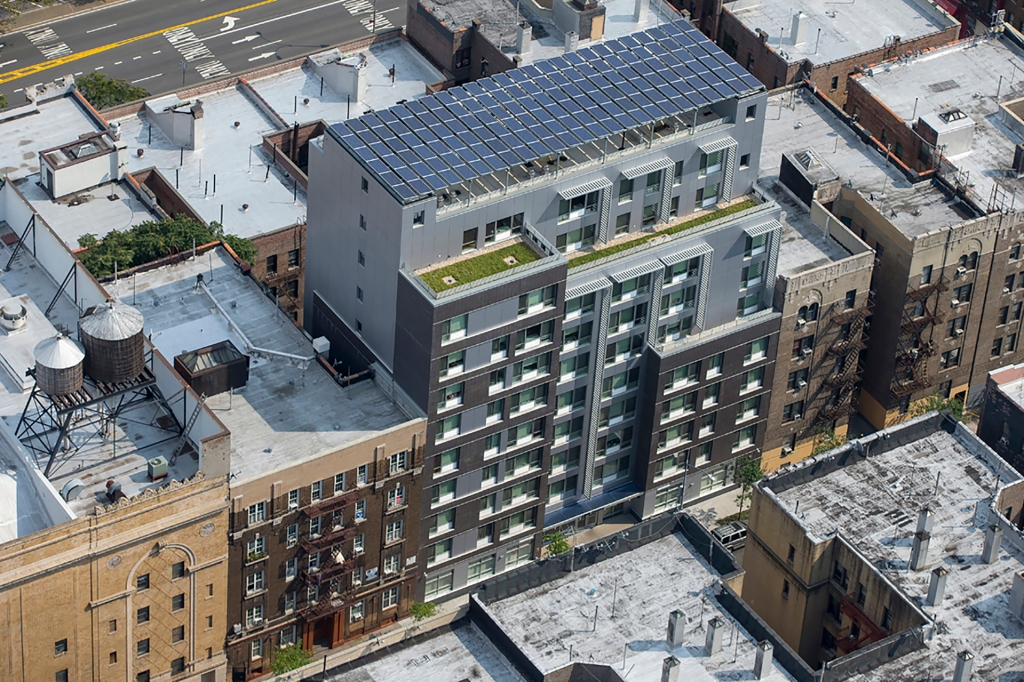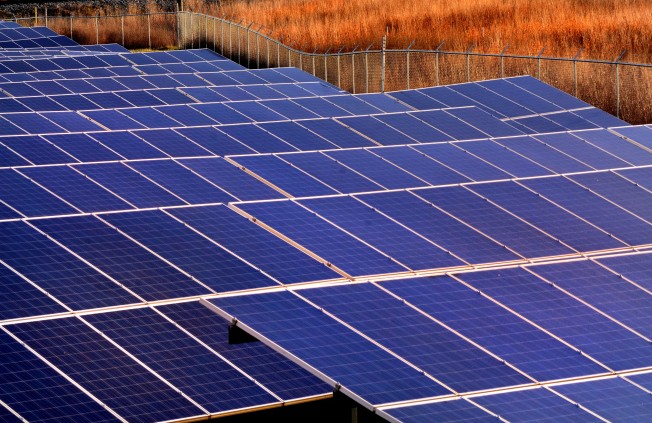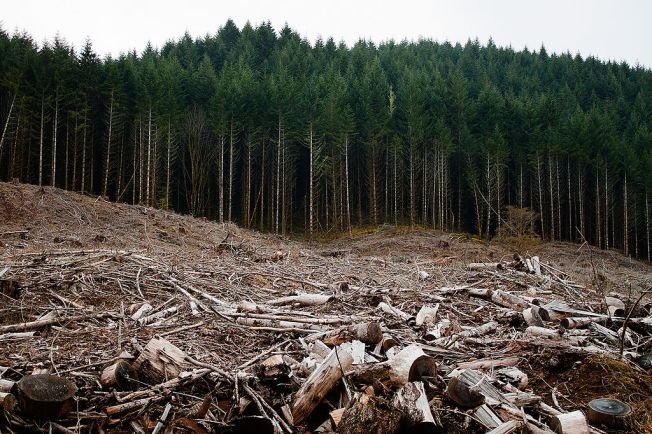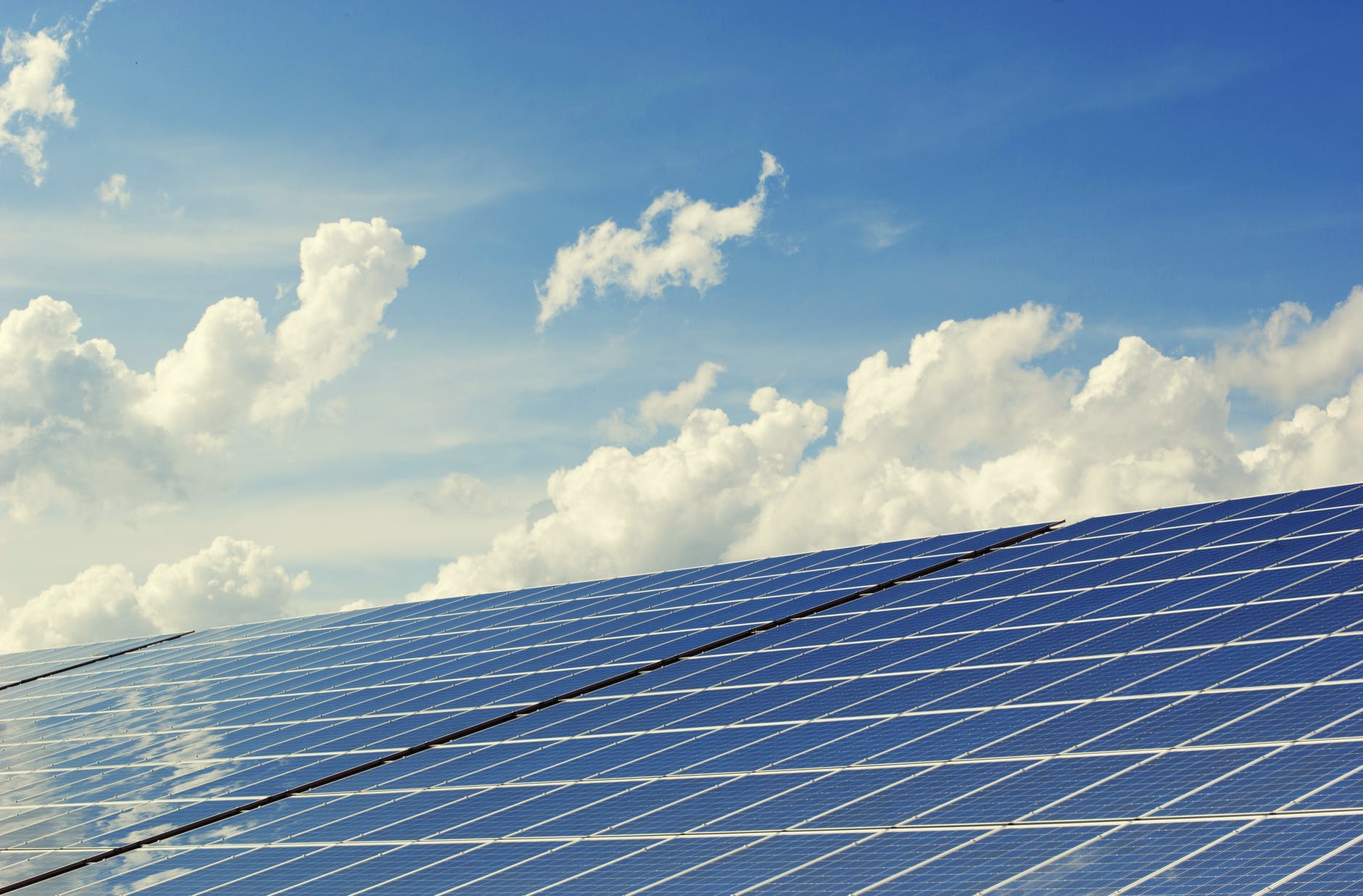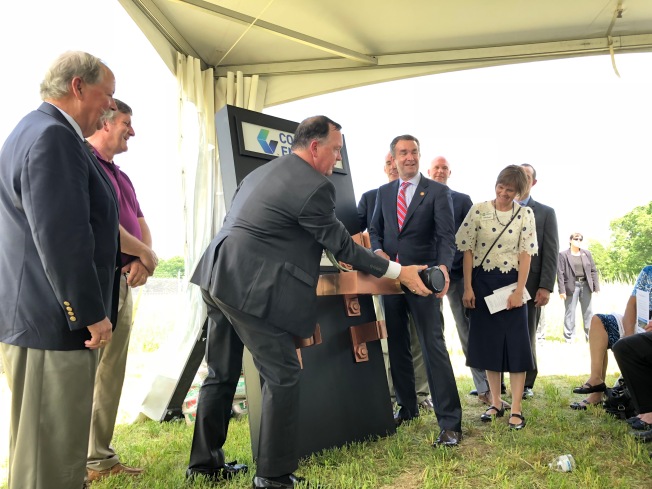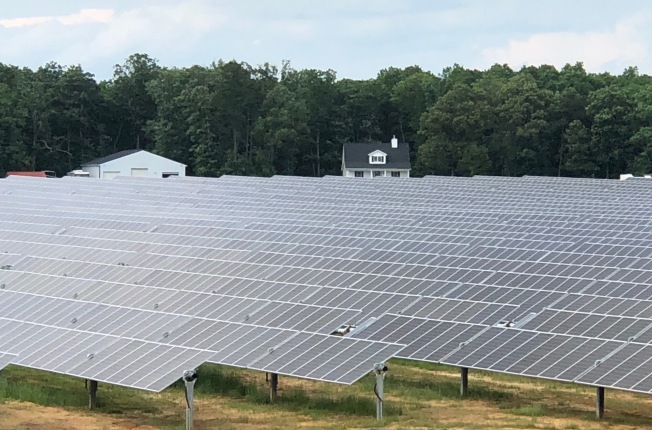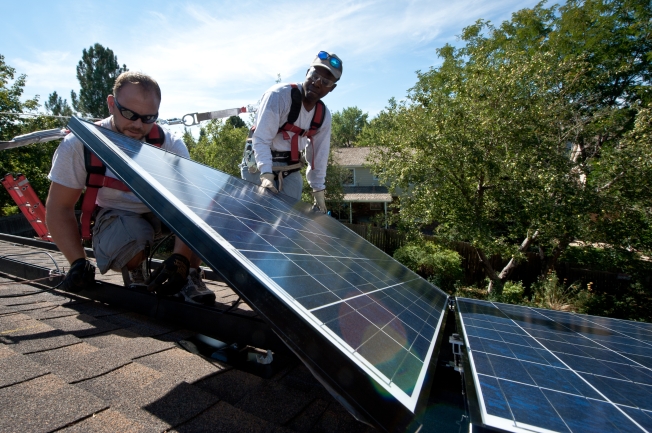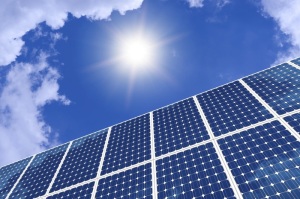
You can tell this picture wasn’t taken in Virginia because it has wind turbines in it. But at least the solar farm will look familiar to many Virginians these days. Photo credit Dennis Schroeder, NREL.
[This is an awesome guide, isn’t it? But you don’t want to bother with it, because the 2018 update is now available here.]
After several years of writing this annual update and often finding little to cheer about, I can finally share some good news. The nationwide boom in utility-scale solar has hit Virginia full force, juiced by low panel prices, corporate and state government demand, favorable tax policy and an abundance of good sites near transmission lines. We are a long way from unleashing our full potential; a lack of incentives, utility-inspired barriers, and a legislature still in thrall to fossil fuel interests continue to hold us back. In spite of this, Virginia is now attracting hundreds of millions of dollars in solar energy investments, and today the solar industry employs more of our residents than the coal industry.
The same cannot be said for wind energy; we are alone among all neighboring states in having no operating wind farms. Distributed generation like rooftop solar also remains a weak spot, even as customer interest continues to grow.
This survey of current policy is intended to help decision-makers, industry, advocates and consumers understand where we are today, who the players are, and where we could be going in the coming year. A few disclaimers: I don’t cover everything, the opinions expressed are purely my own, and as legal advice it is worth exactly what you’re paying for it.
- Overview: Virginia still lags, but we’ve now got some mo’
Even last summer it was clear utility-scale solar was on a roll in the commonwealth, leading me to predict Virginia would hit 200 megawatts (MW) by the end of 2016, up from 22 MW at the end of 2015. According to the Solar Energy Industries Association, we beat that number and then some.
|
Maryland |
North Carolina |
W. Virginia |
Tennessee |
Virginia |
| Solar* |
637.8 |
3,015.8 |
3.4 |
171.1 |
238.3 |
| Wind** |
191 |
208 |
686 |
29 |
0 |
| Total |
828.8 |
3,223.8 |
689.4 |
200.1 |
238.3 |
Installed capacity measured in megawatts (MW) at the end of 2016. One megawatt is equal to 1,000 kilowatts (kW). Note that SEIA does not provide 2016 numbers for W. Virginia; shown are 2015.
*Source: Solar Energy Industries Association **Source: American Wind Energy Association
The big numbers, however, still lie ahead. At the May event where Governor McAuliffe announced his directive to the Department of Environmental Quality (DEQ) to develop a carbon limit for Virginia, he also reported that Virginia has a total of more than 1,800 MW of solar installed or under development.
Several developments are driving these numbers:
- Once the federal investment tax credit is factored in, the levelized cost of energy from solar is now below that of coal, nuclear, and natural gas.
- Dominion committed to 400 MW of solar as part of 2015 legislation, and now indicates in its IRP an intent to build 240 MW per year through at least 2032.
- Governor McAuliffe committed the state to getting 8% of its electricity from solar, a total of 110 MW.
- Corporations, led by Amazon, are using new approaches to procure renewable energy on favorable terms, including indirect and virtual PPAs; this forces utilities to cooperate or be cut out of the action.
- Other customers have stepped up pressure on their utilities to provide renewable energy.
You can find the list of projects that have submitted permit applications on the DEQ website. The list currently does not include regulated utility-owned projects, which until this year received permits from the State Corporation Commission (SCC). Under legislation passed in 2017, however, these projects will also be governed by the DEQ permit-by-rule process.
Industry experts caution that not all of these solar projects will get built; we may even be seeing a speculative bubble of sorts, reflecting a scramble to lock up the good sites now and worry about customers later.
You will find only one wind project on the DEQ list: Apex Clean Energy’s 75 MW Rocky Forge wind farm, which received its permit earlier this year but has not yet begun construction.
And in spite of Dominion Virginia Power having won the right to develop an estimated 2,000 MW of wind power offshore of Virginia Beach, there is still no timeline for offshore wind in Virginia. Dominion continues to include its two-turbine, 12 MW pilot project in its 2017 Integrated Resource Plan, with a projected in-service date of 2021. It does not include the larger resource as an option.
- Most customers still can’t buy renewable energy from Virginia utilities
Currently, the average Virginia resident can’t pick up the phone and call their utility to buy electricity generated by wind and solar farms (unless they are members of some rural electric cooperatives—see below). Worse, they can’t buy renewable energy elsewhere, either.
Virginia law is not the problem. Section 56-577(A)(6) of the Virginia code allows utilities to offer “green power” tariffs, and if they don’t, customers are supposed to be able to go elsewhere for it. Ideally, a utility would use money from voluntary green power programs to build or buy renewable energy for these customers. However, our two big investor-owned utilities, Dominion Energy Virginia (formerly Dominion Virginia Power) and Appalachian Power Company (APCo), have not done this. Instead, the utilities pay brokers to buy renewable energy certificates (RECs) on behalf of the participants. Participation by consumers is voluntary. Participants sign up and agree to be billed extra on their power bills for the service. Meanwhile, they still run their homes and businesses on regular “brown” power.
In Dominion’s case, these RECs meet a recognized national standard, and some of them originate with wind turbines, but they primarily represent power produced and consumed out of state, and thus don’t displace any fossil fuel burning in Virginia. For a fuller discussion of the Dominion Green Power Program, see What’s wrong with Dominion’s Green Power Program.
Since RECs are not energy, Dominion customers are free to buy RECs from other providers, such as Arcadia. If you’re considering this route, read this post first so you understand what you are getting. Personally, I recommend instead making monthly tax-deductible donations to GRID Alternatives to put solar on low-income homes.
Appalachian Power’s “green pricing” program is worse than Dominion’s, consisting only of RECs from an 80 MW hydroelectric dam in West Virginia. In April of 2016 APCo filed a proposal with the SCC for a true renewable energy tariff under of §56-577(A)(6) that would combine wind, solar and hydro. None of the power would come from new projects; partly as a result, the tariff will cost more. That led a hearing examiner to recommend that the SCC reject the tariff as not in the public interest. A ruling by the SCC is expected this summer or fall.
Can you go elsewhere? Since the State Corporation Commission has ruled that REC-based programs do not qualify as selling renewable energy, under the terms of §56-577(A)(6), customers are currently permitted to turn to other licensed suppliers of electric energy “to purchase electric energy provided 100 percent from renewable energy.”
That means you should be able to go elsewhere to buy wind and solar. But Virginia utilities claim that the statute’s words should be read as requiring not only that another licensed supplier provide 100% renewable energy, but that it also supply 100% of the customer’s demand, all the time. Obviously, the owner of a wind farm or solar facility cannot do that. Ergo, say the utilities, a customer cannot go elsewhere.
In August of 2016, a hearing examiner for the SCC rejected this reading in favor of the plain language of the statute. Unfortunately, the case was terminated without the commissioners themselves ruling on the issue.
In spite of the roadblocks, an independent power seller called Direct Energy announced plans last year to sell a renewable energy product to Virginia residents in Dominion’s territory. (The company described the product as a combination of wind and municipal waste biomass.) This spring the SCC confirmed Direct Energy’s right to enter the Virginia market, but also ruled that Direct Energy will have to stop signing up customers once Dominion has its own approved renewable energy tariff. As of this writing, Direct Energy has not decided whether to proceed.
Within a few weeks of the ruling, Dominion filed plans for several new 100% renewable energy tariffs for large commercial customers, and indicated it expected to offer a residential renewable energy tariff as well. Until we see the details, it is hard to know whether this should be viewed as a genuinely positive step for customers or is merely intended to scare off competitors like Direct Energy. Because Dominion’s tariff is designed to meet the company’s “100% of the time” interpretation of the statute, it will include sources like forest biomass, which counts as renewable under the Virginia code but is highly polluting and doesn’t meet many national standards for sustainability. That makes it questionable whether anyone will want to pay extra for its product. If the SCC confirms its hearing examiner’s report rejecting the similar APCo tariff, Dominion may be forced back to the drawing board. (Note to Dominion CEO Robert Blue: Bob, you have the nation’s largest pumped storage facility. Wind, solar and pumped hydro would combine beautifully. You do not need to foist biomass on customers to meet your notion of 100% renewable.)
A new solar option is in the works. For both APCo and Dominion customers, another option is on the way. Under legislation passed this year under the misleading banner of “community solar,” both utilities will contract for power from solar farms to sell to consumers. Details—including price—still have to be worked out in a rulemaking proceeding at the State Corporation Commission. The new programs explicitly do not count as ones selling “electric energy provided 100 percent from renewable energy,” though ironically, they may be the first programs from Dominion and APCo to do exactly that for residential consumers.
Some coop members do have wind and solar options. Recently I learned that there are good green power programs in place in Virginia, available to members of some rural electric cooperatives. Old Dominion Electric Cooperative (ODEC), which supplies power to member cooperatives, buys the output of three wind farms in Maryland and Pennsylvania, and has contracted for two solar farms in Virginia that are slated to come online this year. Not all coops participate; ODEC has the list of those that do on its website.
- Community solar
Dominion loves the name “community solar.” The reality, not so much. The solar tariff discussed in section 2 uses that name but keeps the utility in control and gives customers no ownership interest. Dominion opposed true community solar legislation this year (as in past years) that would have put consumers in the driver’s seat.
This is not the first time Dominion has used the name “community solar” for a program that isn’t. In 2015 Dominion received SCC approval for a program it billed as an offer to sell electricity from solar panels. Unfortunately it turned out the “Dominion Community Solar” program would have involved customers paying extra so Dominion could sell solar energy to other people. Reading the details, it seemed clear it would attract customers only to the extent they didn’t understand it. Fortunately the company still hasn’t launched the program, but I’ve seen no formal withdrawal.
As for true community solar, only one Virginia utility offers it: a member-owned rural electric cooperative in southwestern Virginia called BARC.
- The miserable sham that is Virginia’s Renewable Portfolio Standard (RPS)
Many renewable energy advocates focus on an RPS as a vehicle for inducing demand. In Virginia, that’s a non-starter. Virginia has only a voluntary RPS, which means utilities have the option of participating but don’t have to. And unfortunately, the statute takes a kitchen-sink approach to what counts as renewable energy, so meeting it requires no new investment and no wind or solar. The SCC also insists that utilities take a least-cost approach to meeting the RPS, which means they use RECs from trash incinerators, wood burning, and old out-of-state hydro projects built prior to World War II. If utilities build wind and solar, they are required to sell the high-value RECs from these projects and buy low-cost junky ones instead. Thus, no matter how much solar Dominion builds, the RPS operates to ensure customers will never see solar as part of their energy mix.
The targets are also modest to a fault. Although nominally promising 15% renewables by 2025, the statute sets a 2007 baseline and contains a sleight-of-hand in the definitions section by which the target is applied only to the amount of energy not produced by nuclear plants. The combined result is an effective 2025 target of about 7%.
There appears to be no appetite in the General Assembly for making the RPS mandatory, and efforts to improve the voluntary goals have repeatedly failed in the face of utility and other industry opposition. The utilities have offered no arguments why the goals should not be limited to new, high-value, in-state renewable projects, other than that it would cost more to meet them than to buy junk RECs.
But with the GA hostile to a mandatory RPS and too many parties with vested interests in keeping the kitchen-sink approach going, it is hard to imagine our RPS becoming transformed into a useful tool to incentivize wind and solar.
That doesn’t mean there is no role for legislatively-mandated wind and solar. But it would be easier to pass a bill with a simple, straightforward mandate for buying or building a certain number of megawatts than it would be to repair a hopelessly broken RPS.
- Customer-owned generation
Given the lack of wind or solar options from utilities, people who want renewable energy generally have to build it themselves. Low panel prices and the federal 30% tax credit make it cost-effective for most customers. The emergence of bulk purchasing coops, sometimes also called “solarize” programs, such as those offered through nonprofits VA-SUN and LEAP, makes the process easy for homeowners and businesses and further reduces costs.
Virginia allows net energy metering at the retail rate, though with limits (see section 6). Large commercial customers should also consider the advantages of solar in reducing high demand charges.
In 2016 the GA passed legislation enabling Property Assessed Clean Energy (PACE) loans for commercial customers. Localities now have an option to offer low-cost financing for energy efficiency and renewable energy projects at the commercial level. Arlington County received a federal grant to develop a PACE program that is expected to launch this year and be a model for other jurisdictions. A bill to extend PACE authorization to residential customers did not get out of committee last year.
Virginia offers no cash incentives or tax credits for wind or solar. The lack of a true RPS in Virginia means Virginia utilities generally will not buy solar renewable energy certificates (SRECs) from customers. SRECs generated here can sometimes be sold to utilities in other states or to brokers who sell to voluntary purchasers.
- Limits on retail net metering
Section 56-594 of the Virginia code allows utility customers with wind and solar projects to net energy meter at the retail rate. System owners get credit from their utility for surplus electricity that’s fed into the grid at times of high output. That offsets the grid power they draw on when their systems are producing less than they need. Their monthly bills reflect only the net energy they draw from the grid.
Residential customers can net meter systems up to 20 kW, although standby charges will apply to those between 10 and 20 kW (see section 8). Commercial customers can net meter up to 1,000 kW (1 MW). There is an overall cap of 1% of a utility’s peak demand that can be supplied by net metered systems (as measured at their rated capacity).
If a system produces more than the customer uses in a month, the credits roll over to the next month. However, at the end of the year, the customer will be paid for any excess credits only by entering a power purchase agreement with the utility. This will likely be for a price that represents the utility’s “avoided cost” of about 4.5 cents, rather than the retail rate, which for homeowners is about 12 cents. This effectively stops most people from installing larger systems than they can use themselves.
In 2015, the definition of “eligible customer-generator” was tightened to limit system sizes to no larger than needed to meet the customers demand, based on the previous 12 months of billing history. The SCC wrote implementing regulations (see 20VAC5-315-10 et seq.) but failed to address what happens with new construction.
The limitation presents a new barrier to current customers who want to expand their solar arrays because their business is expanding or they plan to buy an electric car. Why should they have to wait twelve months? But the limitation is also stupid. If customers want to install more clean, renewable energy than they need and are willing to sell the surplus electricity for avoided cost, why would you stop them from performing this service to society?
- Progress on meter aggregation derailed by agricultural solar bill
Under a bill passed in 2013, owners of Virginia farms with more than one electric meter are permitted to attribute the electricity produced by a system that serves one meter (say, on a barn) to other meters on the property (e.g., the farmhouse and other outbuildings). This is referred to as “agricultural net metering.” Unfortunately, there have been complaints from installers about a lack of cooperation from utilities in actually using this provision.
Advocates had hoped that agricultural net metering would be a first step towards broader meter aggregation options, but 2017 legislation instead took agricultural customers in a new direction. Beginning this year, farmers can elect to devote up to a quarter of their acreage to solar panels, up to 1.5 MW or 150% of their own electricity demand. The electricity must be sold to the utility at its avoided cost, while the farmer must buy all its electricity from the utility at retail. A farmer who chooses to do this cannot also use agricultural net metering. Agricultural net metering will be terminated entirely in 2019 in territory served by electric cooperatives, though existing customers are grandfathered.
The change would seem to give farmers no rights they did not already have under federal law, but industry sources I trust say some farmers will indeed be able to make money this way. However, taking away the agricultural net metering option is a backward step for farmers who want to use the solar they produce and aggregate meters.
- Standby charges on larger home systems
The current system capacity limit for net-metered residential solar installations is 20 kW. However, for residential systems between 10 kW and 20 kW, a utility is allowed to apply to the State Corporation Commission to impose a “standby” charge on those customers. Both Dominion and APCo have approval from the SCC to impose standby charges so high that solar installers say the larger systems often don’t make economic sense.
Utilities argue that customers with solar panels don’t pay their fair share of the upkeep of the grid, shifting costs to those who don’t own solar. A range of “value of solar” studies in other states have generally found the reverse, concluding that distributed solar provides a net benefit to the grid and to society at large. A stakeholder group in Virginia completed the initial phase of a value of solar study in 2014 but got no further after the utilities pulled out of the process.
Standby charges and other net metering issues will be a major focus of attention this year as a topic in the “Rubin Group” discussion. See section 19.
- Homeowner associations cannot ban solar
Homeowner association (HOA) bans and restrictions on solar systems have been a problem for residential solar. In the 2014 session, the legislature nullified bans as contrary to public policy. The law contains an exception for bans that are recorded in the land deeds, but this is said to be highly unusual; most bans are simply written into HOA covenants. In April of 2015 the Virginia Attorney issued an opinion letter confirming that unrecorded HOA bans on solar are no longer legal.
Even where HOAs cannot ban solar installations, they can impose “reasonable restrictions concerning the size, place and manner of placement.” This language is undefined. The Maryland-DC-Virginia Solar Energy Industries Association has published a guide for HOAs on this topic.
- Third-party ownership
One of the primary drivers of solar installations in other states has been third-party ownership of the systems, including third-party power purchase agreements (PPAs), under which the customer pays only for the power produced by the system. For customers that pay no taxes, including non-profit entities like churches and colleges, this is especially important because they can’t use the 30% federal tax credit to reduce the cost of the system if they purchase it directly. Under a PPA, the system owner can take the tax credit (as well as accelerated depreciation) and pass along the savings in the form of a lower electricity price.
The Virginia Code seems to sanction this approach to financing solar facilities in its net metering provisions, specifically §56-594, which authorizes a “customer generator” to net meter, and defines an eligible customer generator as “a customer that owns and operates, or contracts with other persons to own or operate, or both, an electrical generating facility that . . . uses as its total source of fuel renewable energy. . . “ (emphasis added).
Notwithstanding this provision, in 2011, when Washington & Lee University attempted to use a PPA to finance a solar array on its campus, Dominion Virginia Power issued cease and desist letters to the university and its Staunton-based solar provider, Secure Futures LLC. Dominion claimed the arrangement violated its monopoly on power sales within its territory. Secure Futures and the university thought that even if what was really just a financing arrangement somehow fell afoul of Dominion’s monopoly, surely they were covered by the exception in §56-577(A)(6) available to customers whose own utilities do not offer 100% renewable energy. (See Section 2, above.)
Yet the threat of prolonged and costly litigation was too much. The parties turned the PPA contract into a lease, allowing the solar installation to proceed but without the advantages of a PPA.
(Note that PPAs are sometimes referred to as “leases,” but they are distinct legally. Leasing solar equipment is like renting a generator; both provide power but don’t involve the sale of the electricity itself. I have never heard of a utility objecting to a true lease.)
In 2013 Dominion and the solar industry negotiated a compromise that specifically allows customers in Dominion territory to use third-party PPAs to install solar or wind projects under a pilot program capped at 50 MW. Projects must have a minimum size of 50 kW, unless the customer is a tax-exempt entity, in which case there is no minimum. Projects can be as large as 1 MW. The SCC is supposed to review the program every two years beginning in 2015 and has authority to make changes to it. I’m not aware the SCC has reviewed the program to date.
Appalachian Power and the electric cooperatives declined to participate in the PPA deal-making, so the legal uncertainty about PPAs continues in their territories. In June of 2015, Appalachian Power proposed an alternative to PPAs. An evidentiary hearing was held September 29, 2015. A veritable parade of witnesses testified that APCo”s program was expensive, unworkable and unnecessary, given the plain language of the statute allowing PPAs.
Almost a year later, on August 31, 2016, the hearing examiner finally issued her report, recommending that APCo’s application be rejected, both because it was a lousy program and because she, too, read the Code to allow PPAs currently, making a utility alternative unnecessary. Before the commission itself could confirm the ruling, APCo withdrew its application.
In 2017, the legislature passed a bill to allow private colleges and universities—but no one else—in APCo territory to use PPAs to install a maximum of 7 MW of renewable energy.
Meanwhile, Secure Futures has developed a third-party-ownership business model that it says works like a PPA for tax purposes but does not include the sale of electricity. This allows the company to install larger projects in more parts of Virginia (including most recently a 1.3 MW solar array to be installed at Carilion New River Valley Medical Center in Southwest Virginia, which I have to mention here because the project combines solar and sheep farming and therefore will make for cute photos). Currently Secure Futures is the only solar provider offering this option, which it calls a Customer Self-Generation Agreement.
- Tax exemption for third-party owned solar
In 2014 the General Assembly passed a law exempting solar generating equipment “owned or operated by a business” from state and local taxation for installations up to 20 MW. It did this by classifying solar equipment as “pollution abatement equipment.” Note that this applies only to the equipment, not to the buildings or land underlying the installation, so real estate taxes aren’t affected.
The law was a response to a problem that local “machinery and tools” taxes were mostly so high as to make third-party PPAs uneconomic in Virginia. In a state where solar was already on the margin, the tax could be a deal-breaker.
The 20 MW cap was included at the request of the Virginia Municipal League and the Virginia Association of Counties, and it seemed at the time like such a high cap as to be irrelevant. However, with solar increasingly attractive economically, Virginia’s tax exemption rapidly became a draw for solar developers, including Virginia utilities.
In 2016 Dominion proposed changing the exemption to benefit its own projects at the expense of those of independent developers. In the end, the statute was amended in a way that benefits utility-scale projects without unduly harming smaller projects. Many new projects will now be only 80% exempt, rather than entirely exempt. However, the details are complex, with different timelines and different size classes, and anyone looking to use this provision should study it carefully.
- Dominion-owned distributed solar
In 2011, the General Assembly passed a law allowing Dominion to build up to 30 MW of solar energy on leased property, such as roof space on a college or commercial establishment. The demonstration program was intended to help Dominion learn about grid integration. The SCC approved $80 million of spending, to be partially offset by selling the RECs (meaning the solar energy would not be used to meet Virginia’s RPS goals). The “Solar Partnership Program” resulted in several commercial-scale projects on university campuses and corporate buildings, but the program did not offer any economic advantages, and it seems to have fizzled out. The new Dominion Energy web page still mentions it, but currently the link does not lead to more information.
- Dominion Solar Purchase Program
The same legislation that enabled the “Solar Partnership” initiative also authorized Dominion to establish “an alternative to net metering” as part of the demonstration program. The alternative is a buy-all, sell-all deal for up to 3 MW of customer-owned solar. As approved by the SCC, the program allows owners of small solar systems on homes and businesses to sell the power and the associated RECs to Dominion at 15 cents/kWh, while buying regular grid power at retail for their own use. Dominion then sells the power to the Green Power Program at a hefty markup. It is not clear whether the program continues to be available; the links on the new Dominion Energy website don’t lead anywhere helpful.
I ripped this program from the perspective of the Green Power Program buyers, but many installers also feel it is a bad deal for customers, given the costs involved and the likelihood that the payments represent taxable income. Finally, selling the electricity may make new system owners ineligible for the 30% federal tax credit on the purchase of the system.
- Utility renewable energy tariffs for large customers
In May of this year, Dominion applied to the SCC for permission to offer six new voluntary schedules for customers with a peak demand of at least 1,000 kW (1 MW). The tariff would use a mix of sources that count as renewable under the Virginia Code but still pollute, including biomass—making it only sort-of green.
For large customers that want wind and solar, the options are more limited. In 2013, Dominion Power introduced a Renewable Generation Tariff to allow customers to buy renewable power from providers, with the utility acting as a go-between and collecting a monthly administrative fee. The program was poorly designed and got no takers.
In 2015, Amazon Web Services made Dominion’s RG tariff irrelevant. Amazon contracted directly with a developer for an 80 MW solar farm, avoiding Dominion’s monopoly restrictions with a plan to sell the electricity directly into the PJM (wholesale) market. Dominion Energy (the merchant affiliate of Dominion Virginia Power) then bought the project, and Dominion Virginia Power negotiated a special rate with Amazon for the power. This contract became the basis for an “experimental” tariff that Dominion now offers to customers with a peak demand of 5 MW or more, with a program cap of 200 MW.
Since that first deal, Dominion and Amazon have followed up with contracts for an additional 180 MW of solar in five Virginia counties.
Dominion used a different model for a deal with Microsoft. After the SCC turned down Dominion’s application to charge ratepayers for a 20-MW solar farm in Remington, Virginia, Dominion reached an agreement with Microsoft and the Commonwealth of Virginia under which the state will buy the output of the project, while Microsoft buys the RECs.
Dominion has also entered into a contract to sell the output of a 17 MW solar facility to the University of Virginia and the Darden School of Business.
Dominion has a strong incentive to make deals with large institutions that want a lot of renewable energy: if they don’t like what Dominion is offering, they can do an end run around the utility. Amazon has shown other companies how to use PJM rules that let anyone develop projects for the wholesale market regardless of utility monopolies, and then “attribute” the solar or wind energy to their operations in any state. With the tax exemption discussed in section 11, Virginia projects apparently now pencil out pretty well.
Some observers caution that the process is still not easy. One of the tasks the Rubin Group says it plans to take on this year is considering further changes to help large customers.
- Dominion continues to add utility-scale solar for its own portfolio
Even before Amazon and Microsoft showed an interest in large-scale solar projects here, Dominion had announced it wanted to develop 400 MW of solar in Virginia. In 2015, two bills promoted the construction of utility-scale solar by declaring it in the public interest for utilities to build solar energy projects of at least 1 MW, and up to an aggregate of 500 MW. The bill was amended at the solar industry’s behest to allow utilities the alternative of entering into PPAs for solar power prior to purchasing the generation facilities at a later date, an option with significant tax advantages.
Dominion got off to a rocky start when the SCC rejected the company’s plan to charge ratepayers for its first project, a 20 MW solar farm in Remington, Virginia because the company had not considered cheaper third-party alternatives. Governor McAuliffe helped save the project by working out a deal with Microsoft, as discussed above. Further projects fared better, however, and Dominion is now so enthusiastic about solar that its latest Integrated Resource Plan (IRP) calls for it to engage in a continuous build-out at a rate of 240 MW per year, all for the benefit of its regular ratepayers.
Although Dominion will be able to charge ratepayers for these projects, the SCC will probably insist that the RECs be sold—whether to utilities in other states that have RPS obligations, or to customers who want them for their own sustainability goals, or perhaps even to voluntary green power customers. If this happens, the result will be that Dominion still won’t use solar to meet the Virginia RPS, and ordinary customers will still not have solar as part of the electricity they pay for. That’s the weird world of RECs for you.
- Governor McAuliffe initiates program to purchase 110 MW of solar
Following a recommendation by the Governor’s Climate Change and Resiliency Commission, on December 21, 2015, Governor McAuliffe announced that the Commonwealth would commit to procuring 8% of its electricity from solar, with 75% of that built by Dominion and 25% by private developers.
The first deal that will count towards this goal is an 18 MW project at Naval Station Oceana, announced on August 2, 2016. The Commonwealth will buy the power and the RECs. (The Remington Project did not count, because as the buyer of the RECs, only Microsoft can claim the right to be buying solar power.) A 17 MW solar farm supplying the University of Virginia will also count towards the 8%, according to Deputy Secretary of Commerce and Trade Hayes Framme.
- Still waiting for wind
No Virginia utility is actively moving forward with a wind farm on land. Dominion Power’s website used to list 248 MW of land-based wind in Virginia as “under development,” without any noticeable progress. The current web page omits mention of these projects.
On the other hand, Appalachian Power’s most recent IRP suggests an interest in wind as a low-cost renewable resource. The bad news is that it isn’t proposing to build any new wind in Virginia.
With no utility buyers, Virginia has not been a friendly place for independent wind developers. In previous years a few wind farm proposals made it to the permitting stage before being abandoned, including in Highland County and on Poor Mountain near Roanoke.
Nonetheless, Apex Clean Energy has obtained a permit to develop a 75-MW Rocky Forge wind farm in Botetourt County. No customer has been announced, but the company believes the project can produce electricity at a competitive price, given its good location and improved turbine technology. Construction, once planned for this year, is now slated for 2018.
As for Virginia’s great offshore wind resource, little progress has been made towards harnessing it, even as the nation’s first offshore wind project began generating electricity in the waters off Rhode Island last year. Dominion won the federal auction for the right to develop about 2,000 MW of wind power off Virginia Beach in 2013, and the company has completed a Site Assessment Plan (SAP) that is awaiting approval.
We had originally been told the federal government’s timeline would lead to wind turbines being built off Virginia Beach around 2020. Now, however, the Bureau of Ocean Energy Management says Dominion has five years from approval of the SAP to submit its construction and operations plan, after which we’ll have to wait for review and approval. Presumably the project will also require an environmental impact statement. So the whole process would be quite slow even if Dominion were committed to moving forward expeditiously.
But in fact, it seems increasingly clear that Dominion is just going through the motions and has little interest in seeing the project through. Its 2017 Integrated Resource Plan (IRP) does not even include offshore wind in any of its scenarios for the next 15 years, except for the 12 MW that would be produced by the two test turbines of its VOWTAP project.
Yes, so what about VOWTAP? Dominion had been part of a Department of Energy-funded team to try out new technology, with two pilot turbines due to be installed in 2017. After a second round of bids to build the project still came in higher than expected, Dominion told DOE last spring it could not commit to construction even by 2020, upon which DOE pulled funding. Dominion executives have not declared the project dead, however, and while there has been no public discussion of reviving it, the 2017 IRP suggests an in-service date of 2021.
[Update: on July 10, 2017, Dominion announced it had signed a memorandum of understanding with Denmark-based DONG Energy, one of the largest offshore wind developers in Europe, to complete the two pilot turbines. According to a Dominion press release, the MOU also gives DONG “the exclusive rights to discuss a strategic partnership with Dominion Energy about developing the commercial site based on successful deployment of the initial test turbines.”]
- The EPA Clean Power Plan is (probably) dead; long live the McAuliffe clean energy plan!
The Trump administration’s pullback on the Paris accord and the Clean Power Plan are depressing evidence that the Koch brothers have more influence on government than the American people do. Yet the practical effect in Virginia is small. The Clean Power Plan’s targets for Virginia were modest to a fault, and the state could have written an implementation plan that complied with the federal law while still allowing construction of an unlimited number of new gas-burning plants, sending total carbon emissions soaring.
Governor McAuliffe’s recent Executive Directive 11, on the other hand, ties emissions reductions from Virginia power plants to those in other states that have committed to reducing carbon emissions, leaving somewhat less room for mischief in implementation. There are still plenty of pitfalls ahead, and some Republican leaders have vowed to prevent it from ever taking effect. But any constraints on greenhouse gas emissions would serve to increase the value of emissions-free sources like wind and solar. The DEQ web page will show public participation opportunities.
- Solar initiatives underway ahead of the 2018 Session
The legislative initiatives that passed in 2017 dealt primarily with utility-scale solar. Since then, the solar industry has announced plans to focus more on removing barriers to distributed generation, a decided challenge given the utilities’ determination to curtail net metering.
The utilities and the solar industry have reconvened solar policy discussions via the Rubin Group, named for its moderator, Mark Rubin. Steering committee members this year include the electric cooperatives, Dominion, APCo, the solar industry trade group MDV-SEIA, the farm advocate Powered by Facts, the environmental group Southern Environmental Law Center, and the Virginia Manufacturer’s Association. The Rubin Group held a meeting on June 19 to get input from other stakeholders, and a follow-up email announced plans for the following subgroups:
- Large Customer (Convener: Katharine Bond, Dominion Energy, with Advanced Energy Economy, Ceres, and World Wildlife Fund as Key Participants)
- Large Developer/Utility-Scale Solar (Convener: Francis Hodsoll, SolUnesco & MDV-SEIA Board Member)
- Net Metering (Co-Conveners: Sam Brumberg, Virginia’s Electric Cooperatives & Scott Thomasson, Vote Solar & MDV-SEIA Board Member)
- Land Use (Convener: Karen Schaufeld, Powered by Facts)
- Community Solar Implementation for Dominion Energy (Conveners: Katharine Bond & Nate Frost, Dominion Energy)
The Rubin Group will accept comments at RubinGroup2017@gmail.com. [Update: Although this was the email address given out at the public meeting, we have learned it goes to Sam Brumberg, attorney for the electric cooperatives, who says he checks it only a few times per month. He recommends contacting Mark Rubin directly at rubin.mark3@gmail.com.]
A separate initiative is the Virginia Distributed Solar Alliance, which includes solar companies, environmental groups, consumers and solar advocates, but not utilities. As its name suggests, it focuses on removing barriers to smaller-scale, customer-sited projects, defending net metering and educating the public about the added benefits distributed solar bring to the grid and the community. The VA-DSA recently launched its website and is welcoming members.


